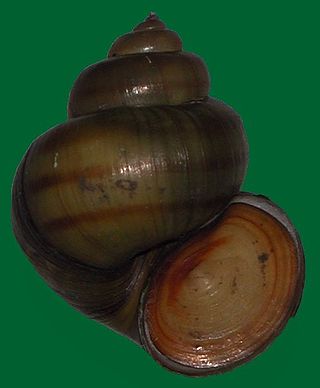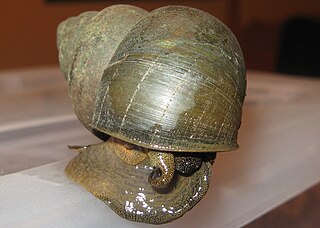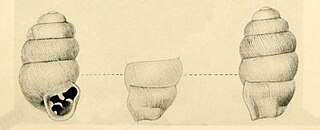
Thomas Say was an American entomologist, conchologist, and herpetologist. His studies of insects and shells, numerous contributions to scientific journals, and scientific expeditions to Florida, Georgia, the Rocky Mountains, Mexico, and elsewhere made him an internationally known naturalist. Say has been called the father of American descriptive entomology and American conchology. He served as librarian for the Academy of Natural Sciences of Philadelphia, curator at the American Philosophical Society, and professor of natural history at the University of Pennsylvania.

Conchology is the study of mollusc shells. Conchology is one aspect of malacology, the study of molluscs; however, malacology is the study of molluscs as whole organisms, whereas conchology is confined to the study of their shells. It includes the study of land and freshwater mollusc shells as well as seashells and extends to the study of a gastropod's operculum.

Bermuda land snails, scientific name Poecilozonites, are an endemic genus of pulmonate land snail in the family Gastrodontidae. 12 species are known from the fossil record, and 4 of these species survived into modern times, but due to the highly negative effects of human development, the extant species has been reduced down to only bermudensis and circumfirmatus.

The Scotch bonnet is a medium-sized to large species of sea snail, a marine gastropod mollusk in the subfamily Cassinae, the helmet shells and bonnet shells. The common name "Scotch bonnet" alludes to the general outline and color pattern of the shell, which vaguely resemble a tam o' shanter, a traditional Scottish bonnet or cap. The shell is egg-shaped and fairly large, 2 to 4 inches in maximum dimension, with a regular pattern of yellow, orange or brown squarish spots. The surface sculpture of the shell is highly variable: the surface can be smooth and polished, have grooves, be granulated, or even be nodulose on the shoulder of the whorls.

Viviparidae, sometimes known as the river snails or mystery snails, are a family of large operculate freshwater snails, aquatic gastropod mollusks.

Sinistrofulgur perversum, the lightning whelk, is a species of very large predatory sea snail or whelk, a marine gastropod mollusc in the family Busyconidae, the busycon whelks. This species has a left-handed or sinistral shell. It eats mostly bivalves.

The Chinese mystery snail, black snail, or trapdoor snail, is a large freshwater snail with gills and an operculum, an aquatic gastropod mollusk in the family Viviparidae. The Japanese variety of this species is black and usually a dark green, moss-like alga covers the shell.

Cipangopaludina is a genus of freshwater snails with a gill and an operculum, aquatic gastropod mollusks in the family Viviparidae.

Tonna galea, commonly known as the giant tun, is a species of marine gastropod mollusc in the family Tonnidae. This very large sea snail or tun snail is found in the North Atlantic Ocean as far as the coast of West Africa, in the Mediterranean Sea and the Caribbean Sea. The species was first described by Carl Linnaeus in 1758.
Auriculella malleata is a species of tropical air-breathing land snails, terrestrial pulmonate gastropod mollusks. This species is endemic to the United States (Hawaii).

Vertigo arthuri is a species of land snail in the family Vertiginidae, the whorl snails. It is known by the common names callused Vertigo, or Midwest Pleistocene Vertigo.

Vertigo modesta, common name the cross vertigo, is a species of minute air-breathing land snail, a terrestrial pulmonate gastropod mollusk or micromollusk in the family Vertiginidae, the whorl snails.
Echinostoma cinetorchis is a species of human intestinal fluke, a trematode in the family Echinostomatidae.
Spurwinkia salsa is a species of very small aquatic snail, an operculate gastropod mollusk in the family Cochliopidae.

Shell jewelry is jewelry that is primarily made from seashells, the shells of marine mollusks. Shell jewelry is a type of shellcraft. One very common form of shell jewelry is necklaces that are composed of large numbers of beads, where each individual bead is the whole shell of a small sea snail. Numerous other varieties of shell jewelry are made, including bracelets and earrings.

Conus is a genus of predatory sea snails, or cone snails, marine gastropod mollusks in the family Conidae. Prior to 2009, it included all cone snail species but is now more precisely defined, as are other cone snail genera.
Cipangopaludina lecythoides is a species of a freshwater snail with an operculum and a gill, an aquatic gastropod mollusk in the family Viviparidae, the river snails.
Cipangopaludina miyagii is a species of large, freshwater snail with an operculum and a gill, an aquatic gastropod mollusk in the family Viviparidae, the river snails. This freshwater snail found only in Southern part of Taiwan.

Helminthoglypta diabloensis, or the silky shoulderband snail, is a North American species of air-breathing land snail. It is found in California, including the California Coast Ranges, Diablo Range, and other areas in Alameda, Contra Costa, Santa Clara, Yolo, Colusa and Napa Counties. The shell of H. diabloensis is described as having six to seven tightly coiled whorls.













